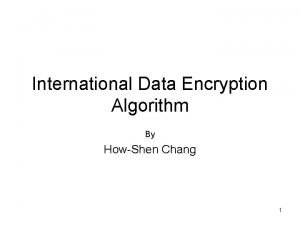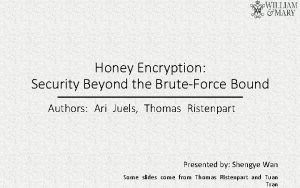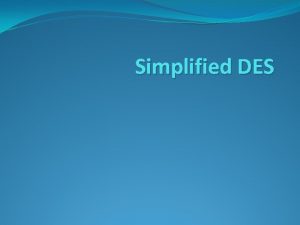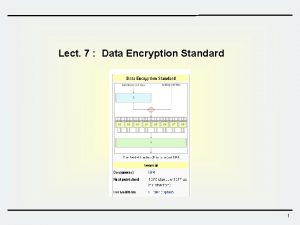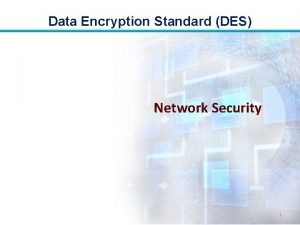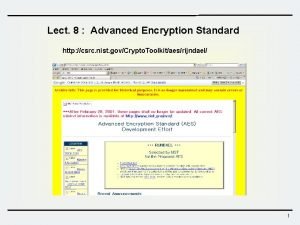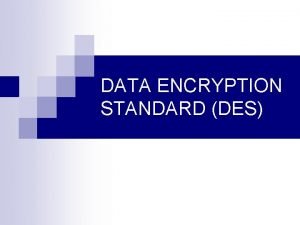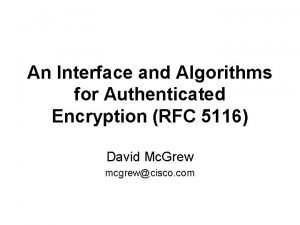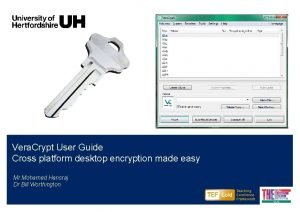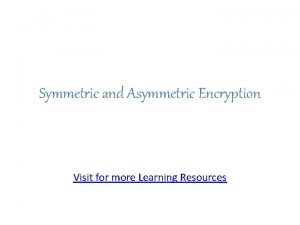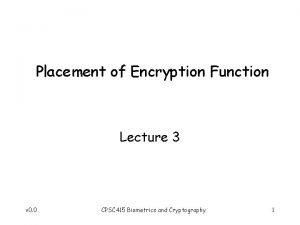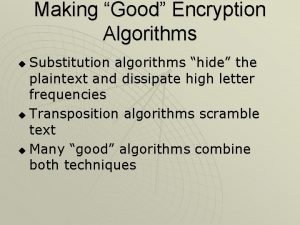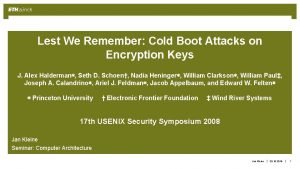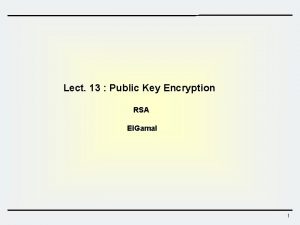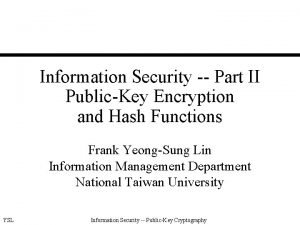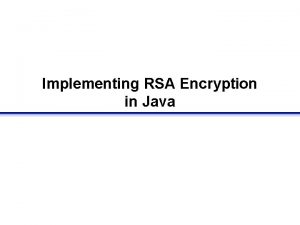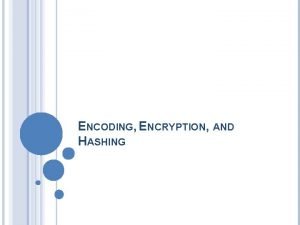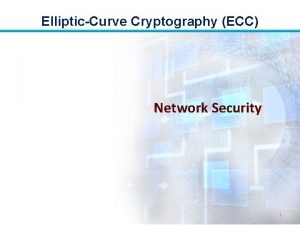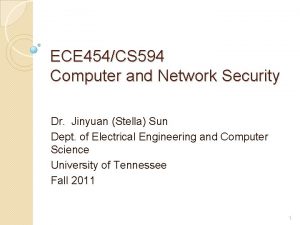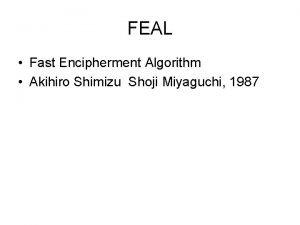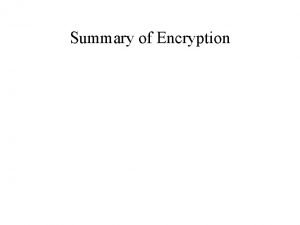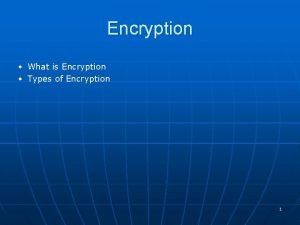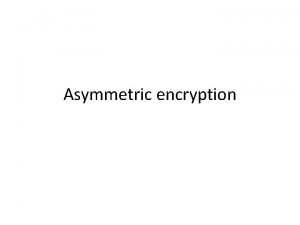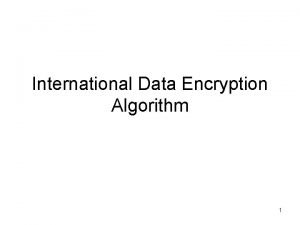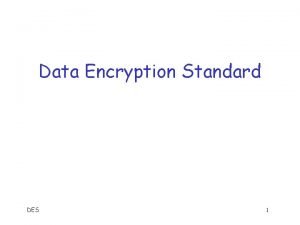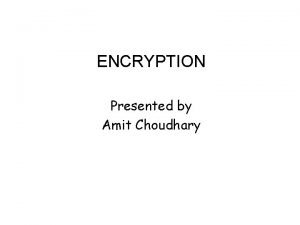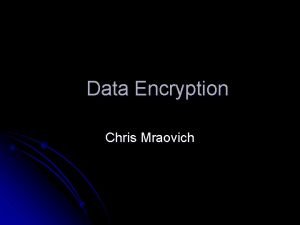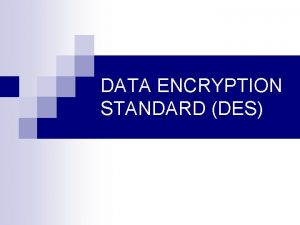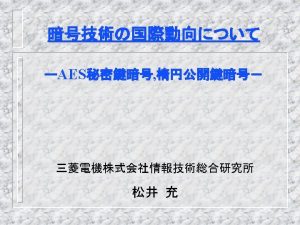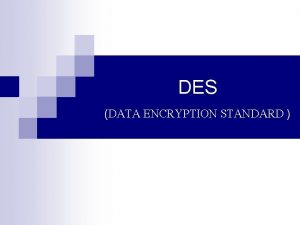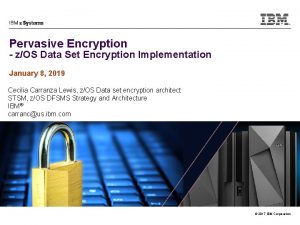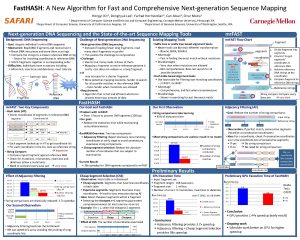FEAL 1 FEAL Fast data Encryption ALgorithm q






























- Slides: 30

FEAL 1

FEAL Fast data Encryption ALgorithm q Invented, promoted by NTT in 1987 q o Japanese telecommunications monopoly Designed as replacement for DES q And to be fast and efficient q o With modest security q Original version (FEAL-4) found to be weak o Many “improved” versions followed o All are flawed to some degree FEAL 2

FEAL-4 q Here, we consider FEAL-4 q Important in history of cryptanalysis q Differential cryptanalysis developed to attack FEAL-4 o Powerful method to analyze block ciphers q We present differential and linear attacks on FEAL-4 FEAL 3

Differential and Linear Attacks q Differential and linear attacks are usually only of theoretical interest o Large chosen (known) plaintext requirement FEAL-4 is an exception q Both differential and linear attacks on FEAL-4 are practical q o So these attacks fit theme of the book o And introduce important cryptanalysis methods FEAL 4

FEAL-4 Cipher q FEAL-4 is a 4 -round Feistel cipher with a 64 -bit block and 64 -bit key q Several different (but equivalent) ways to describe the cipher q Description for differential attack o 64 -bit key six 32 -bit subkeys o Round function F maps 32 bits to 32 bits FEAL 5

FEAL-4 Cipher q Plaintext: P q Ciphertext: C q Round function: F q 32 -bit subkeys: K 0, K 1, …, K 6 q XOR: q Very simple cipher! FEAL 6

FEAL-4 Round Function Define G 0(a, b) = (a + b (mod 256)) <<< 2 G 1(a, b) = (a + b + 1 (mod 256)) <<< 2 q Where “<<<” is left cyclic shift (rotation) q Then F(x 0, x 1, x 2, x 3) = (y 0, y 1, y 2, y 3) where q y 1 = G 1(x 0 x 1, x 2 x 3) y 2 = G 1(y 1, x 2 x 3) FEAL y 0 = G 0(x 0, y 1) y 3 = G 1(y 2, x 3) 7

FEAL-4 Round Function q Schematic of FEAL-4 round function o Note the XORs Differential attack: “difference” is XOR q By considering differences, the cipher is simplified q FEAL 8

FEAL-4 Differential Attack A chosen plaintext attack q Two plaintexts, specified difference q o Difference is known as a characteristic For example if X is the characteristic, P 0 P 1 = X q Note, we can choose P 0 at random and let P 1 = P 0 X q Are there any useful characteristics? q FEAL 9

FEAL-4 Differential Attack q Note: A 0 A 1 = 0 implies F(A 0) = F(A 1) q Easy to show that if A 0 A 1 = 0 x 80800000 then for round function F we have F(A 0) F(A 1) = 0 x 02000000 q And it holds with probability 1 q Differential attack based on this… FEAL 10

FEAL-4 Differential Attack q Choose plaintext P 0 and P 1 so that P 0 P 1 = 0 x 80800000 q Given corresponding C 0 and C 1 q Let P = P 0 P 1 and C = C 0 C 1 q Consider P as it “passes thru cipher” o Under “ ” subkeys drop out of cipher FEAL 11

FEAL-4 Differential Attack q Characteristic for P gets us half way thru q Can then work backwards from C q Try to meet in middle o Note L , R are known FEAL 12

FEAL-4 Differential Attack q We have L = 0 x 02000000 Z q Which give us Z q Also, Y = 0 x 80800000 X q Note: For C = (L, R) we have Y = L R q Now we can solve for subkey K 3 o Next slide… FEAL 13

FEAL-4 Differential Attack q We have Z = 0 x 02000000 L q Compute Y 0=L 0 R 0, Y 1=L 1 R 1 q Guess K 3 and compute putative Z 0, Z 1 o Note: Zi = F(Yi K 3) q Compare FEAL true Z to putative Z 14

FEAL-4 Differential Attack q Using 4 chosen plaintext pairs o Work is of order 232 o Expect one K 3 to survive q Good divide and conquer strategy q But it is possible to do better! o Can reduce work to about 217 q Relies on structure of F function o See next slide… FEAL 15

FEAL-4 Differential Attack q For 32 -bit word A=(a 0, a 1, a 2, a 3), define M(A) = (z, a 0 a 1, a 2 a 3, z) where z is all-zero byte q For all possible A=(z, a 0, a 1, z), compute Q 0 = F(M(Y 0) A) and Q 1 = F(M(Y 1) A) q Can be used to find 16 bits of K 3 FEAL 16

FEAL-4 Differential Attack q For all A = (z, a 0, a 1, z), compute Q 0 = F(M(Y 0) A) and Q 1 = F(M(Y 1) A) q When A = M(K 3) by defn of F, we have Q 0 Q 1 8… 23 = Z 8… 23 where X i…j is bits i thru j of X q Can recover K 3 with about 217 work FEAL 17

FEAL-4 Differential Attack q Primary for K 3 q Assuming FEAL q Secondary for K 3 only one chosen plaintext pair 18

FEAL-4 Differential Attack q Once K 3 is known, can successively recover K 2, K 1, K 0 and finally K 4, K 5 o Attack is similar in each case o Some require different characteristics o There a few subtle points q See FEAL the homework problems! 19

Differential Attacks In FEAL-4, differential for K 3 holds with probability 1 q In most differential attacks, probability is small, which q o Increases chosen plaintext requirement o Increases work factor Differential cryptanalysis seldom practical q Usually only a theoretical tool q FEAL 20

FEAL-4 Linear Attack q Consider this equivalent form of FEAL-4 q Known plaintext attack… FEAL 21

FEAL-4 Linear Attack Let X be 32 -bit word, X = (x 0, x 1, …, x 31) q Define Si, j(X) = xi xj and Si(X) = xi q o Also extends to sum of more than 2 bits Attack uses fact that for bytes a and b, S 7(a b) = S 7(a + b (mod 256)) q Recall G 0(a, b) = (a + b (mod 256)) <<< 2, so that S 5 G 0(a, b) = S 7(a b) q Also, S 5 G 1(a, b) = S 7(a b) 1 q FEAL 22

FEAL-4 Linear Attack Have S 5 G 0(a, b) = S 7(a b) q And S 5 G 1(a, b) = S 7(a b) 1 q Let Y = F(X), where X, Y are 32 -bit words q Then it can be shown that S 13(Y) = S 7, 15, 23, 31(X) 1 S 5(Y) = S 15(Y) S 7(X) S 15(Y) = S 21(Y) S 23, 31(X) S 23(Y) = S 29(Y) S 31(X) 1 q FEAL 23

FEAL-4 Linear Attack q Label FEAL-4 intermediate steps q Use formulas on previous slide… FEAL 24

FEAL-4 Linear Attack q It can be shown that a = S 23, 29(L 0 R 0 L 4) S 31(L 0 L 4 R 4) S 31 F(L 0 R 0 K 0) q Where a = S 31(K 1 K 3 K 4 K 5) S 23, 29(K 4) Treat a as unknown, but constant q Exhaust over all choices for K 0 q o Test all known plaintext/ciphertext pairs o If a is not constant, putative K 0 is incorrect FEAL 25

FEAL-4 Linear Attack q Linear FEAL attack to find K 0 26

FEAL-4 Linear Attack q Possible to improve on linear attack of previous slide o Exhaust for 12 bits of K 0 first, then… o Work is much less than 232 (see text) q Can extend this attack to recover other subkeys FEAL 27

Confusion and Diffusion Modern block ciphers employ both confusion and diffusion q FEAL-4 is a Feistel cipher q o With round function F(X Ki) o Diffusion: shift bytes in F and bits in G 0, G 1 o Confusion: XOR of Ki and addition q FEAL-4: diffusion and confusion are weak FEAL 28

FEAL-4 Conclusion Weak block cipher q Important in modern cryptanalysis q o Many variants in FEAL cipher family o All broken Differential cryptanalysis developed for FEAL q Good example to illustrate both linear and differential attacks q FEAL 29

Linear and Differential Attacks q Important tools to analyze ciphers o Used in block cipher design q Seldom practical methods of attack for block ciphers q Will see again with hash functions o In particular, differential attacks FEAL 30
 International data encryption algorithm
International data encryption algorithm Define feal
Define feal Swot analiza hotela
Swot analiza hotela Decrypt
Decrypt Simplified des
Simplified des Differentiate between acid fast and non acid fast bacteria
Differentiate between acid fast and non acid fast bacteria Example of acid-fast bacteria
Example of acid-fast bacteria Block ciphers and the data encryption standard
Block ciphers and the data encryption standard Data encryption standard exercice corrigé
Data encryption standard exercice corrigé Data encryption standard
Data encryption standard Des in information security
Des in information security @??????:http://pnrtscr.com/ck08e6
@??????:http://pnrtscr.com/ck08e6 Data encryption standard history
Data encryption standard history Authenticated encryption with associated data (aead)
Authenticated encryption with associated data (aead) A* vs ao* algorithm
A* vs ao* algorithm Sweep line algorithm cp algorithm
Sweep line algorithm cp algorithm Elasticsearch service statistics
Elasticsearch service statistics Fast data analysis
Fast data analysis Vera encryption
Vera encryption Homomorphic encryption standard
Homomorphic encryption standard Symmetric encryption advantages and disadvantages
Symmetric encryption advantages and disadvantages Explain about the placement of encryption function.
Explain about the placement of encryption function. New-omeconfiguration
New-omeconfiguration Making good encryption algorithms
Making good encryption algorithms Lest we remember: cold boot attacks on encryption keys
Lest we remember: cold boot attacks on encryption keys Rsa el
Rsa el Public key encryption
Public key encryption Rsa algorithm java
Rsa algorithm java Encoding encryption and hashing
Encoding encryption and hashing Encryption decrypti
Encryption decrypti Crc encryption
Crc encryption
